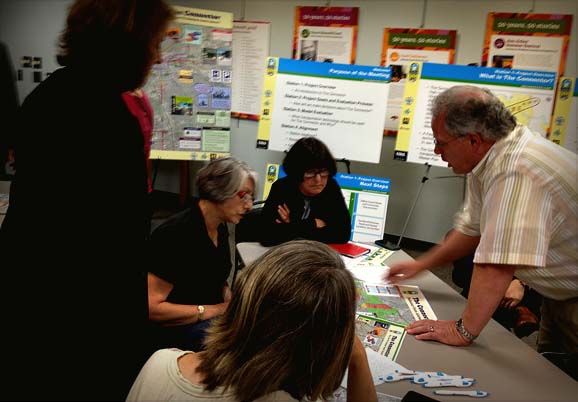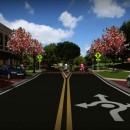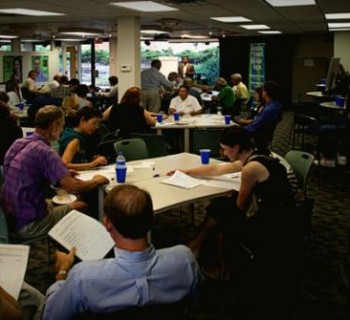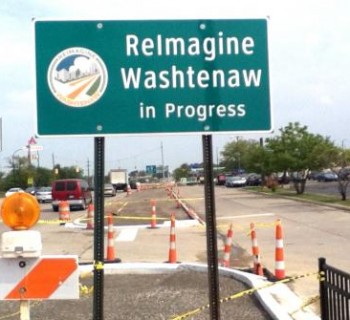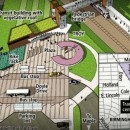ANN ARBOR, Mich.—If you've ever watched the State Street/I-94 interchange turn into a parking lot at rush hour, it's hard to imagine packing even more commuters on this major thoroughfare in the coming years. The same goes for Fuller Road, where up to 60 Ann Arbor Transit Authority and University of Michigan buses try to make their way amidst other vehicles at peak travel times. But if Ann Arbor development continues, more people will be coming. So, how will people ever get anywhere on time?
One potential solution is the “Ann Arbor Connector," a high-capacity transit system being explored by the AATA, U-M, the Downtown Development Authority, and the City of Ann Arbor. The Connector would provide more efficient transit from northeast to south Ann Arbor, with stops at major locations downtown, on campus, and around the U-M Health System.
The Connector plan is just a concept for the time being, but the Connector Committee started research and planning for the project earlier this year. They contracted with URS Corporation, an engineering, construction and technical services firm, to lead a feasibility study.
URS Vice President Richard Nau, during a public overview at the Ann Arbor Public Library June 18, shared several types of high-capacity transit options that were evaluated for their potential fit to community needs and concerns:
- Bus to enhance the existing bus system, working with standard buses on existing streets
- Bus rapid transit that will include an integrated system of guideway stations, services and amenities that collectively improve the speed, reliability and identity of bus transit. This generally operates in exclusive right-of-way with frequent stops
- Light rail electric powered transit vehicles operating on standard railroad tracks generally in exclusive right-of-way with single or multiple car trains. Power is provided by overhead wires.
- Automated guideway system of electrically powered transit vehicles operating in an exclusive guideway with single or multiple car trains. Power is provided in the guideway. Generally these systems are elevated above ground.
“The idea is that we are going to get four to five fairly well-defined options, and they might consist of bus options, they might consist of rail options. They might consist of options of mixed flow or options with dedicated rights of way,” said Nau as he described the overall planning process.
During the process, the committee looked at cities comparable to Ann Arbor in terms of size and need that were able to meet similar goals for implementing a high-capacity transit system.

Eugene, Ore. now has a four-mile bus rapid transit system that improved connections between high-density, high-traffic zones and the University of Oregon. Eugene's implementation led to a 28 percent reduction in travel time and a more than 80 percent increase in ridership through that transit corridor.
Cleveland, Ohio put in a 6.8 mile bus rapid transit line that encouraged $4.3 billion in development along its corridor. Travel time reduced in this corridor by 10 minutes, due to operation in exclusive traffic lanes, wider station spacing, and collecting fares off-board.
The Committee’s evaluation also revealed some of the reasons why certain transit options would not work well in Ann Arbor. Elevated guideway transit option would require significantly higher capital costs than other modes because it requires a continuous elevated guideway to be constructed. That elevated guideway would also be a visual obstruction across Ann Arbor, particularly in the historic portions of downtown.
The committee determined that light rail and bus rapid transit options could be configured to have similar benefits at much lower cost. For that reason, the committee decided not to further explore elevated guideway as a high-capacity transit option.
As exciting as these plans may be, Ann Arbor commuters will still struggle through congestion for a few more years. There is still a lot of planning work to do, like identifying routes, considering station points, and gauging financial impact, and projected implementation isn't until 2020.
“We’re in a multi-step process, and we are trying to narrow the number of alternatives that we do detailed financial work for. We’ll do a much more detailed analysis to see how many riders we’re carrying on a daily basis, what impact does that have on the road system, what impact does that have on the surrounding area, and also what impact does that have on capital and operating costs. That is a necessary and planned part of our analysis,” Nau stated.
The committee is seeking public input throughout the study to make sure the plan accurately reflects the needs of all stakeholders. The next phase of the project will focus on potential routes and stations before a financial analysis of capital costs for the most preferred high-capacity transit modes begins.
Information on public input sessions will be posted on The Ann Arbor Connector website:
For more news about the Connector project, visit AnnArbor.com


